Blepharitis is an inflammation of the eyelids. It can be categorised by time course (acute or chronic) or by anatomical location of the lid margin disease (anterior or posterior). Acute blepharitis in children can be caused by infections such as Herpes simplex or impetigo and presentation can be in the form of a hordeolum.1
Figure 1: A lower lid external hordeolum with scabbing of the skin
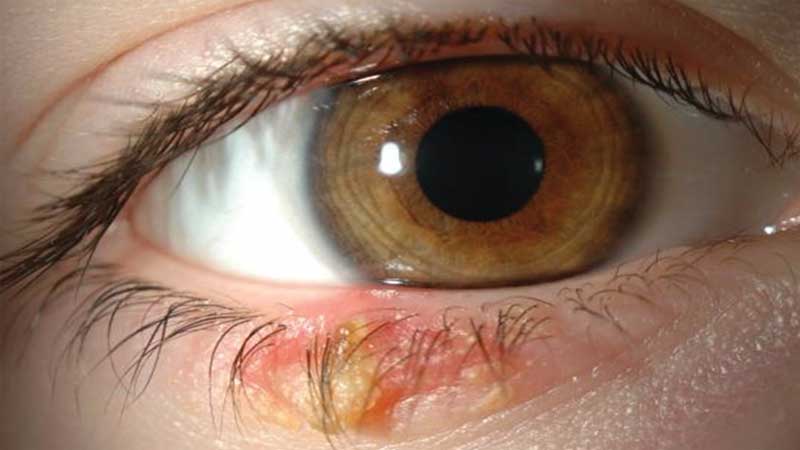
Anterior blepharitis encompasses staphylococcal disease. It is an inflammation of the portion of the lid margin anterior to the grey line known as the muscle of Riolan; the marginal portion of the orbicularis oculi muscle.2 Posterior blepharitis is an inflammation of the portion of the lid margin posterior to the grey line. Structures involved include the Meibomian gland orifices and the mucocutaneous junction. Anterior and posterior blepharitis frequently co-exist and can be termed marginal or mixed blepharitis.3,4

Seborrhoeic blepharitis can involve both the anterior and posterior lid margins. There tends to be less inflammation than staphylococcal blepharitis, and the meibomian glands can be affected. The glands which are derived from sebaceous glands are in a hypersecretory state producing a greasier deposition on the lid margin.5-7
Meibum is composed of polar and non-polar lipids, and plays an important role in protecting the eye against harmful microbes and maintaining a stable tear film. Functions of meibum in tear film stability are:8
- Maintaining a smooth optical surface for clear vision.
- Preventing evaporation of the aqueous component of the tears.
- Spreading of tears evenly on the ocular surface.
- Preventing spill over of tears onto the lid margins by forming a hydrophobic barrier.
Meibomian gland dysfunction (MGD) is a cause of posterior blepharitis.8 In MGD there is an anomaly of the meibum secreting meibomian glands of the lids resulting in qualitative and quantitative changes to their secretions. In MGD, the gland orifices become capped and blocked with meibum that has become thick and difficult to express. Changes to the constituents of meibum cause an increase in its melting point contributing to the obstruction of flow in blepharitis.9 Blockage can also occur due to hyperkeratinisation of epithelial cells within the glands that obstruct the gland lumen.4
The cause of blepharitis is multifactorial and not fully understood. Staphylococcal aureus has been isolated in higher frequency from the lid margins of individuals with staphylococcal blepharitis and a combination of staphylococcal and seborrhoeic blepharitis.10 An individual’s cell mediated immune response to the cell walls of S. aureus is also thought to play a role in the pathogenesis of blepharitis.11,12 This article will focus on the effects of chronic blepharitis in the paediatric population.
Predisposing factors
There is a significant association between seborrhoeic dermatitis and seborrhoeic blepharitis.13 In children seborrhoeic dermatitis has a bimodal peak of occurrence affecting infants within the first three months of life and then later adolescents during puberty. In infants, seborrhoeic dermatitis manifests itself as cradle cap; a self-limiting, non-pruritic dermatitis affecting the scalp.14 The condition is characterised by pale yellow to brown greasy scales on the scalp that do not affect hair growth.15 During puberty signs are excessive scalp dandruff and scales particularly in areas where there are skin creases. The dermatitis is found in areas of the body rich in sebaceous glands and thought to be caused by over colonisation of yeast (Malassezia) and hormonal changes.16,17
Figure 2: (a) A Keeler portable slit lamp and a hand held slit lamp in use (b).
A
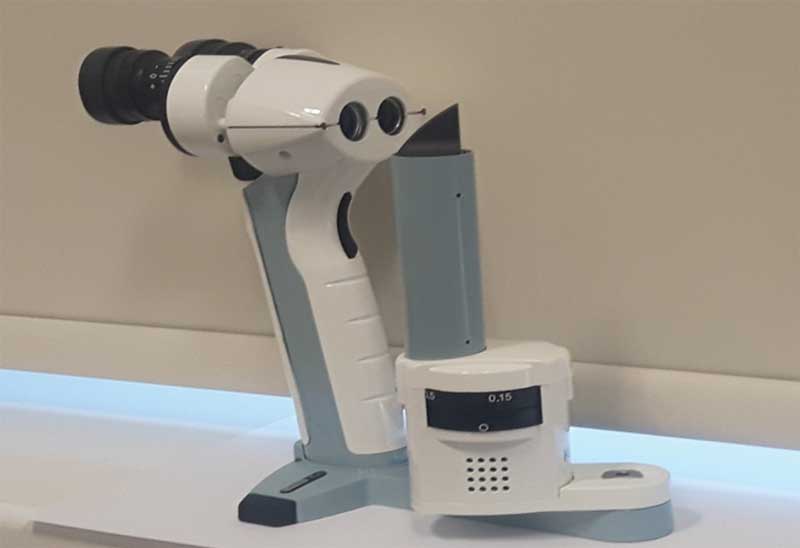
B
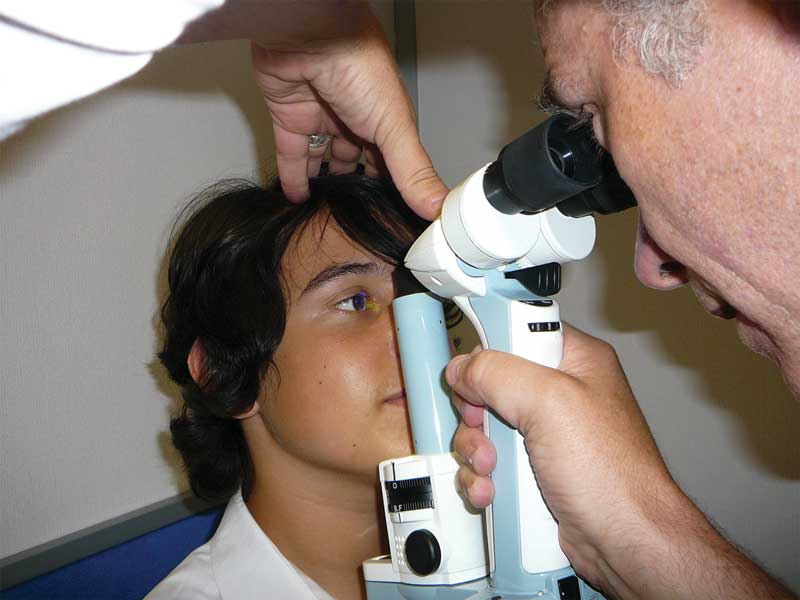
Dry eye is a predisposing factor for blepharitis. Primary dry eye disease is rare in children, although it does occur in Triple A syndrome; also known as Achalasia Addisonianism Alacrima syndrome or Allgrove syndrome. This is a rare congenital condition characterised by achalasia (a disorder of the oesophagus where it becomes difficult for food to pass into the stomach), Addison’s disease (abnormality of the adrenal glands) and alacrima (absent or insufficient tear production).18,19 There are numerous other causes of secondary dry eye such as juvenile idiopathic arthritis and Stevens-Johnson syndrome.20,21
In cutaneous rosacea, the sebaceous glands are affected. The ophthalmic manifestation of the skin condition is known as ocular rosacea.21-24 It is associated with blepharitis, meibomitis, conjunctival hyperaemia and a secondary keratitis. Some degree of facial rosacea is present in around 20-50% of children with ocular rosacea.25 Gonser et al26 found that there was little correlation between ocular and cutaneous signs. Cases of acne rosacea in prepubescent children with associated keratitis have been reported in the literature.27 Chamaillard et al28 carried out a retrospective study and suggested that all children with cutaneous rosacea should have an ophthalmic examination to rule out ocular manifestations of the disease. Cutaneous signs may be discrete and precede facial signs and symptoms.
Demodex folliculorum, though associated with blepharitis, has a relatively low prevalence in healthy young children.29,30
Symptoms
Below is a list of common symptoms associated with blepharitis in children:
- Discomfort
- Burning
- Redness
- Blurred vision
- Watery eyes
- Sensitivity to light
- Discharge
- Eye rubbing
Blepharokeratoconjunctivitis
Blepharokeratoconjunctitis (BKC) is the umbrella term used to describe a whole host of complications affecting the lids, conjunctiva and cornea that can result from chronic paediatric blepharitis. Indicators to disease are chronic ocular discomfort, intermittent photophobia and recurrent chalazion.22 Due to the large spectrum of clinical features the condition is underdiagnosed. Several studies have evaluated the incidence. Gupta et al31 reviewed 5,012 paediatric patient notes of children attending Lady Hardinge Medical College and associated Kalawati Saran Children Hospital in New Delhi, India over a three year period. A diagnosis of BKC was present in 615 children (12%). Another study by Hammersmith et al32 reviewed the case notes of new referrals to a US based specialist tertiary corneal service over five years. One hundred and ninety-five records were reviewed. BKC was the diagnosis in 15% of cases.
BKC is usually bilateral but asymmetric and chronic in nature.33 The condition can present in infants as young as six months but mean age of onset of symptoms is four years. Mean age of presentation to the eye department for diagnosis is approximately six years.22,31,32 This delay between onset of symptoms and diagnosis has been found in several studies (table 1) and accounts for a reduction in visual acuity.22,32-35 This highlights the importance of increased awareness of the clinical characteristic of BKC, particularly the early features to avoid the potentially sight threatening inflammatory sequelae.
The clinical course of BKC is one of exacerbations and remissions, with disease ranging from mild to severe that begins to subside around puberty.35 Advanced disease has been found to be more common in South Asian, South East Asian and Middle Eastern children.23,33 In a multi-ethnic study conducted on a small number of paediatric patients at Moorfields Eye Hospital (n=44), Viswalingam et al33 found that 50% of children with BKC were of South Asian origin.33 Both South Asian and Middle Eastern children were more likely to have 360 degrees of cornel neovascularisation.33 A severe phenotype of the disease has been identified in white adolescents.35
Signs of BKC
Lids
No matter the severity of BKC, lid involvement is always present and a prerequisite for the condition.23,32 Inflammation of the lids can result in recurrent styes and chalazia which can be ascertained from a careful history and the clinical examination32 (figure 1). Lid signs can often be subtle therefore a comprehensive slit lamp examination with high magnification is required (table 2). Having a portable slit lamp available is useful for the examination of infants and younger children (figure 2).
Conjunctiva
Conjunctival involvement in BKC can manifest itself as conjunctival hyperaemia figure 3. Studies found this to be present to some degree in 100% of cases. In a study conducted at Great Ormand Street Hospital, Jones et al22 found all 27 study participants had conjunctival hyperaemia. Similarly, in a larger study in New Delhi, India, Gupta and colleagues31 found conjunctival hyperaemia to be present in all 615 children with a diagnosis of BKC.
Figure 3: Conjunctival hyperaemia with inferior nasal corneal vascularisation in BKC
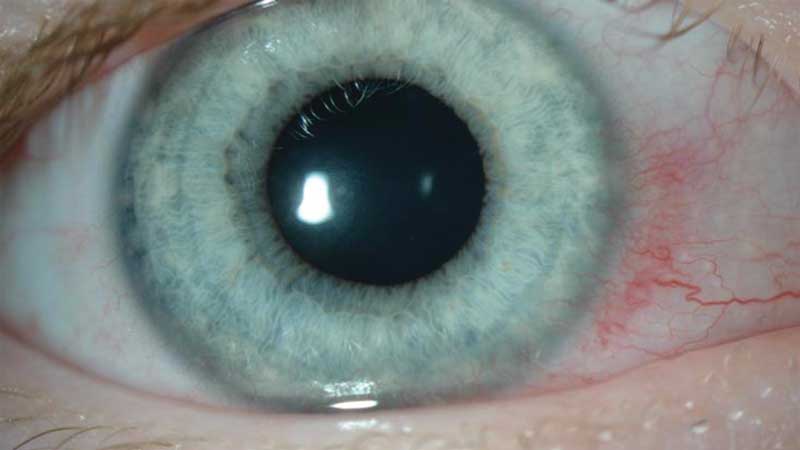
Lid eversion is important in an examination where BKC is suspected as children can have cellular infiltration of the tarsal conjunctiva resulting in conjunctival thickening. There can also be a papillary and follicular conjunctivitis.33 Conjunctival changes can lead to persistent conjunctival damage.35 In more severe cases conjunctival phlyctenules can appear. A phlycten or phlyctenule is a raised white nodule formed on the cornea or conjunctiva occurring due to a delayed hypersensitivity response to S. aurus.22 They have a predilection for the female gender and are most commonly found inferiorly on the ocular surface.36
Table 2: Summarises the features of eye lid involvement
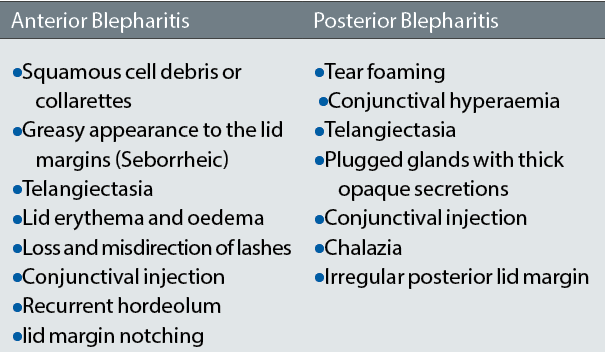
Figure 4: Superficial Punctate Keratitis

Cornea
Corneal involvement occurs in up to 81% of paediatric BKC cases.22 Punctate epithelial erosions are common on the inferior cornea in early disease. As the disease progresses an epithelial and sub-epithelial punctate keratopathy can be present35 (figure 4). Marginal stromal infiltrates can develop with corneal vascularisation initially starting in one sector then spreading circumferentially around the cornea (figure 5 and 6). A phlyctenule can also develop on the cornea (figure 7). Corneal ulceration, thinning and scarring can develop in advanced disease23 and if it involves the cornea, it can induce astigmatism.22 In severe disease where there is extensive corneal involvement, residual damage and scarring can cause amblyopia if the visual axis is involved35,37(figure 8). Where there is resolved corneal involvement, approximately one third of patients have visual acuity of less than 6/9 in the affected eye.22,34 In rare instances the condition can be so severe that corneal perforation occurs.39,38
Differential diagnosis
Differential diagnosis of BKC in children include:25,37
- Keratoconus – usually present in older children and accompanied by irregular astigmatism and other features of keratoconus such as corneal striae and scarring.
- Allergic eye disease – can present with similar symptoms of watering and photophobia, but a major differentiating symptom is excessively itchy eyes. Macropapillae may be present.
- Viral conjunctivitis – can have similar symptoms but the recurrent nature of BKC is a tell-tale sign.
- Microbial keratitis – rarer, usually presenting in older contact lens wearing children.
- Herpes simplex keratitis (HSK) – often confused with BKC, usually unilateral with presentation at a similar age but with less lid involvement. Reduced corneal sensation is present in HSK. Dendritic ulceration and disciform scarring may be present.
- Preseptal cellulitis – Acute presentation in a systemically unwell child. Ptosis may be present. Requires emergency referral.40
Figure 5: Sectoral corneal neovascularisation and corneal scarring
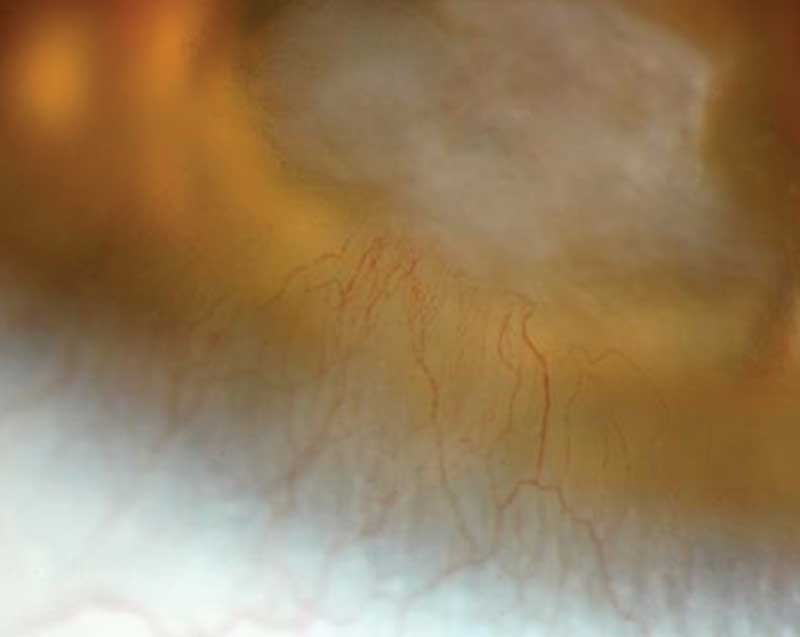
Figure 6: Corneal new vessels with stromal lipid leakage
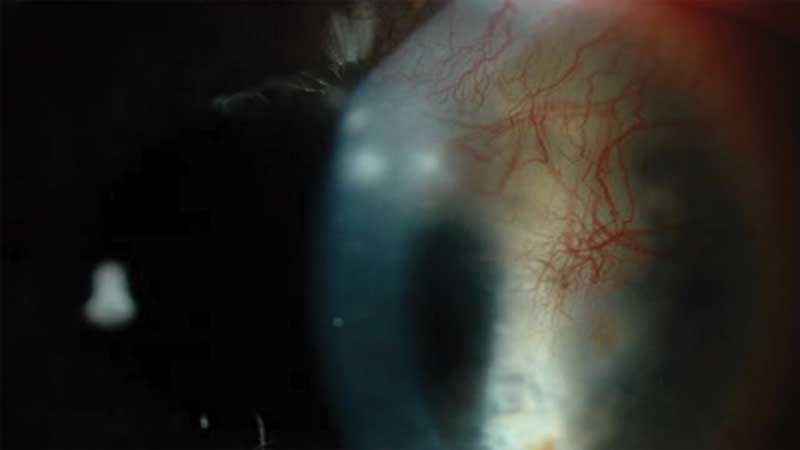
Figure 7: Phylectenule changes and conjunctival injection of (a) the right and (b) the left eyes of the same patient
A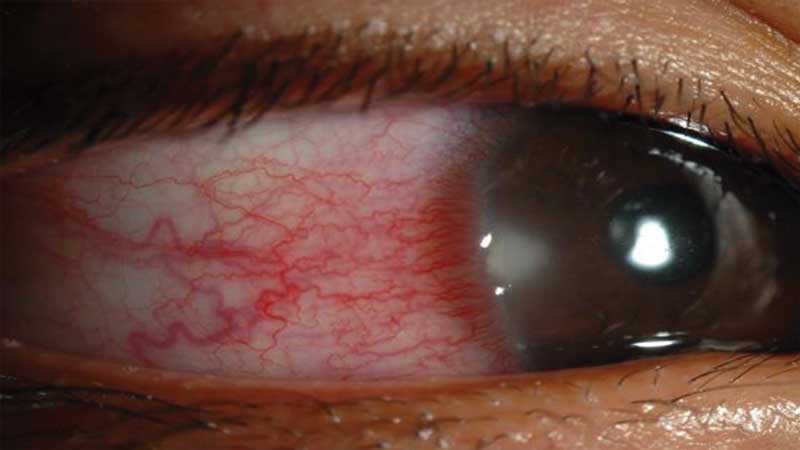 B
B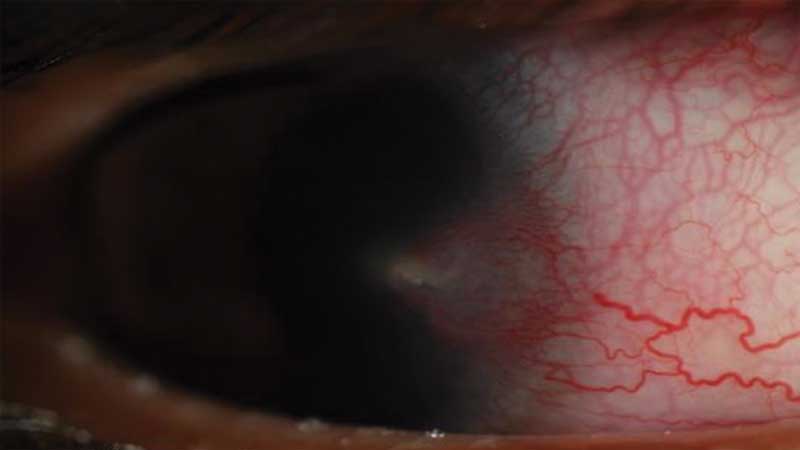
Treatment
The goals of treatment are to relieve symptoms in blepharitis, and limit corneal involvement that could lead to scarring and visual loss in BKC.41 This can be achieved by reducing the bacterial load on the lids, increasing the quality of the meibomian gland secretions and controlling the immune response to bacterial antigen. Adhering to a strict treatment regimen in children can be a challenge as lid hygiene and drop instillation can be difficult with younger children and older children may have compliance issue.
Non-pharmacological treatment
Good lid hygiene is important, and this should be performed both in the acute and chronic phases of disease. Cleaning the lids can be carried out using cooled boiled water, diluted baby shampoo or commercially available wipes. Hot compress and lid massage should also be carried out daily. Modified techniques, where lids margins are rubbed with a clean fingertip while bathing, may be better suited to infants and younger children.22
Regular refractions are crucial as corneal scarring can induce astigmatism and the spectacle prescription can change frequently as corneal changes advance or recede.21,22 Rigid gas permeable contact lenses may be required for extensive scarring in older children. For children in the amblyogenic period, occlusion therapy or atropine penalisation is necessary where visual acuity does not improve with spectacles.22
Pharmacological treatment
S. aureus and S. epidermides are organisms isolated from the lids and conjunctiva of patients with BKC.33 Topical antibiotic treatment with agents such as chloramphenicol, fusidic acid and ciprofloxacin are used to reduce the bacterial load, and prophylactically where an epithelial defect is present.21,22 Ointments are preferred for children if available due to the reduced frequency of instillation and longer contact time on the ocular surface. As well as instilling into the fornix, the ointment should be rubbed onto the lashes and lid margins.
In flare ups of BKC, high potency steroids are used such as 0.1% dexamethasone and 1% prednisolone eye drops. If there is severe corneal involvement, instillation should be two hourly and then gradually tapered to once daily. Lower potency steroids 0.1% fluorometholone and 0.5% loteprednol etabonate are used for milder episodes of inflammation. These lower potency steroids can also be used for longer periods of time once daily for several months as a maintenance dose to keep inflammation at bay. They are sometimes given to be used at the parents’ discretion, up to twice daily for a few weeks in the event of exacerbation of symptoms along with the advice to attend eye casualty if flare ups do not subside.
Steroids should be used with caution and minimised due to the increased risks of infection, cataract and glaucoma. A younger age is a predisposing factor for steroid induced ocular hypertension. The College of Optometrists clinical management guidelines recommend a baseline intraocular pressure (IOP) measurement prior to the commencement of steroid therapy, and subsequently IOP measurements at two weeks, then monthly for two to three months, then six monthly for patients newly started on steroid treatment.42
Secondary dry eye is a feature of BKC and topical lubricating drops can be instilled regularly to increase comfort. Preservative free preparations should be used where possible so as not to aggravate ocular surface inflammation.
Studies have found that cyclosporin eye drops can effectively treat children with a phlyctenular keratoconjunctivitis when therapy with conventional lid hygiene, oral antibiotics and topical steroids has failed. Cyclosporin is an immunosuppressant; its mode of action is to prevent T cells from producing the cytokine interleukin 2. Doan et al43 found ciclosporin eye drops to be effective in a small number of children, (n=11) in Bichat Hospital, Paris, France.43 They found that the drug was successful in causing corneal neovascularisation to regress and controlling inflammation in all eyes of children previously dependent on topical steroid drops during the study’s one year follow up period.43
Children who do not show adequate response to topical therapy can be treated with orally administered drugs. Classes of drugs used for oral treatment are the macrolides and tetracyclines.44
Tetracyclines are licensed for the treatment of acne in children aged 12 years and over.45 Their use is contraindicated in younger children due to the drug binding to calcium, retarding bone growth, causing yellowing of the teeth and in some cases dental hypoplasia.
The most common macrolide used is erythromycin. It has been shown to be an effective and relatively safe alternative in the treatment of BKC, causing an improvement in lid inflammation and resolution of corneal disease.38 Its mode of action is inhibiting lipid and bacterial protein synthesis.21,33 It comes in tablet, capsule and oral suspension form which makes it easier to administer to children. The main side effect of systemic use is gastrointestinal upset. Infrequently systemic immunosuppression therapy is also used to control inflammation.35
Supplementation with omega 3; flaxseed oil, has been explored in BKC as an alternative therapy when oral antibiotics have been stopped. Documented dosing is 1 teaspoon daily tapering to alternate days for a six month period.22 Flaxseed oil has anti-inflammatory properties and thins the meibum secreted by the meibomian glands which can help alleviate the symptoms of secondary dry eye associated with BKC.21
Surgical management
Chalazia that persist despite hot compresses and massage may require surgical management of incision and curettage. An alternative to this for older children who are keen to avoid surgery is intralesional triamcinolone actetonide injections, although there is a higher recurrence rate than with removal of the chalazia.46 The use of anti-vascular endothelial growth factor injections to assist regression of corneal neovascularisation has also been reported.41 In extreme cases with visually debilitating corneal scarring or perforation, a corneal graft may be required or corneal gluing with cyanoacrylate.35 In severe BKC with corneal scarring and thinning the chance of needing surgical intervention is 26%.23 For dry eye symptoms punctal plugs can be inserted if despite frequent use of lubricating eye drops, symptoms persist or the frequent instillation of the drops to a child becomes too onerous.21
Figure 8: Scarring across the visual axis resulting in amblyopia in BKC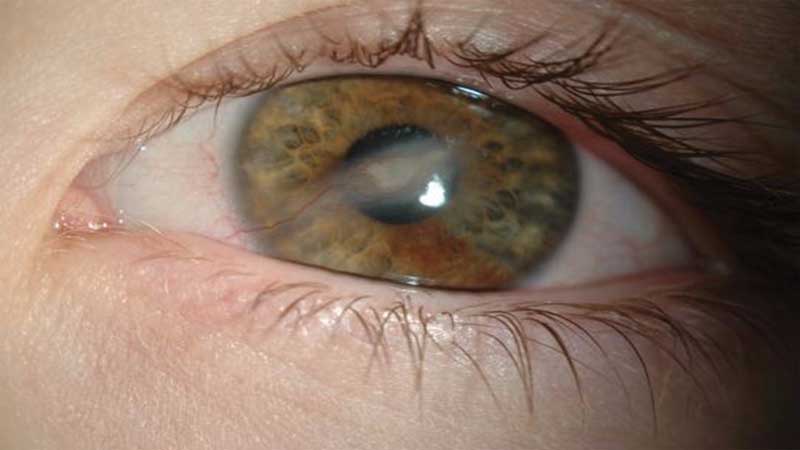
Conclusion
The effect of blepharitis in children is more profound than in the adult population.22 Symptoms precede diagnosis by approximately two years. Early detection and treatment of blepharitis in children, and appropriate referral for topical or systemic treatment by the eye care practitioner can enable disease symptoms to be controlled, and good vision to be maintained.37 Frequent follow up is important and intervals are guided by the clinical course of the disease. •
Yetunde Obadeyi is a specialist optometrist at Moorfields Eye Hospital.
Acknowledgements
Ms Lynne Speedwell, head of optometry Great Ormond Street Hospital. Photographs courtesy of Becky MacPhee and Patricia Ibanez Rios.
References
- Tuft, S.J. ed., (2013). External eye disease and the oculocutaneous disorders. In: Pediatric ophthalmology and strabismus, 4th edn. London; Edinburgh: Elsevier Saunders, pp.105-138
- Wulc, A.E., Dryden, R.M. and Khatchaturian, T. (1987) 'Where is the gray line?', Archives of ophthalmology (Chicago, Ill.: 1960), 105(8), pp. 1092-1098.
- https://www.aao.org/preferred-practice-pattern/blepharitis-ppp--2013 accessed 13/5/18
- Nichols, K. (2010) Blepharitis and dry eye: a common, yet complicated combination: the diseases often co-present, which may confound treatment priorities Jobson Medical Information LLC.
- Lindsley, K., Matsumura, S., Hatef, E. and Akpek, E.K. (2012) 'Interventions for chronic blepharitis', The Cochrane database of systematic reviews, (5):CD005556. doi(5), pp. CD005556. doi: 10.1002/14651858.CD005556.pub2 [doi].
- McCulley, J.P., Dougherty, J.M. and Deneau, D.G. (1982) 'Classification of chronic blepharitis', Ophthalmology, 89(10), pp. 1173-1180. doi: 10.1016/S0161-6420(82)34669-2.
- Foulks, G.N. and Bron, A.J. (2003) 'Meibomian Gland Dysfunction: A Clinical Scheme for Description, Diagnosis, Classification, and Grading', The Ocular Surface, 1(3), pp. 107-126. doi: 10.1016/S1542-0124(12)70139-8.
- Nelson, J.D., Shimazaki, J., Benitez-del-Castillo, J.M., Craig, J.P., McCulley, J.P., Den, S. and Foulks, G.N. (2011) 'The international workshop on meibomian gland dysfunction: report of the definition and classification subcommittee', Investigative ophthalmology & visual science, 52(4), pp. 1930. doi: 10.1167/iovs.10-6997b.
- McCulley, J.P. and Shine, W.E. (2003) 'Meibomian Gland Function and the Tear Lipid Layer', The Ocular Surface, 1(3), pp. 97-106. doi: 10.1016/S1542-0124(12)70138-6.
- Dougherty, J.M. and McCulley, J.P. (1984) 'Comparative bacteriology of chronic blepharitis', The British journal of ophthalmology, 68(8), pp. 524-528. doi: 10.1136/bjo.68.8.524.
- Ficker, L., Ramakrishnan, M., Seal, D. and Wright, P. (1991) 'Role of cell-mediated immunity to staphylococci in blepharitis', American Journal of Ophthalmology, 111(4), pp. 473-479. doi: S0002-9394(14)72383-9 [pii].
- Seal, D., Ficker, L., Ramakrishnan, M. and Wright, P. (1990) 'Role of staphylococcal toxin production in blepharitis', Ophthalmology, 97(12), pp. 1684-1688. doi: 10.1016/S0161-6420(90)32361-8.
- McCulley, J.P. and Dougherty, J.M. (1985) 'Blepharitis associated with acne rosacea and seborrheic dermatitis', International ophthalmology clinics, 25(1), pp. 159-172.
- Chiriac, A., Chiriac, A.E., Murgu, A. and Foia, L. (2012) 'Seborrheic dermatitis eye lid involment (seborrheic blepharitis) in children not a rare clinical observation', Nasza Dermatologia Online, 3(1), pp. 52-53.
- Schwartz, R.A., Janusz, C.A. and Janniger, C.K. (2006) 'Seborrheic dermatitis: an overview', American Family Physician, 74(1), pp. 125.
- Fleischer, A.B. (2008) 'Diagnosis and Management of Common Dermatoses in Children: Atopic, Seborrheic, and Contact Dermatitis', Clinical pediatrics, 47(4), pp. 332-346. doi: 10.1177/0009922807309421.
- Poindexter, G.B., Gabriele B. Poindexter, Craig N. Burkhart and Dean S. Morrell (01) 'Therapies for Pediatric Seborrheic Dermatitis', Pediatric annals, 38(6), pp. 333-338.
- https://rarediseases.info.nih.gov/diseases/457/triple-a-syndrome#ref_2496 accessed 17/5/18
- Brooks, B.P., Kleta, R., Caruso, R.C. and Stuart, C. (01) 'Triple-A syndrome with prominent ophthalmic features and a novel mutation in the AAASgene: a case report', BMC ophthalmology, 4(1).
- Alves, M., Dias, A.C. and Rocha, E.M. (2008) 'Dry Eye in Childhood: Epidemiological and Clinical Aspects', The Ocular Surface, 6(1), pp. 44-51. doi: 10.1016/S1542-0124(12)70104-0.
- Wong, I.B.Y., FRCSEd(Ophth) and Nischal, K.K., FRCOphth (2010) 'Managing a child with an external ocular disease', Journal of AAPOS, 14(1), pp. 68-77. doi: 10.1016/j.jaapos.2009.11.021.
- Jones, S.M., Weinstein, J.M., Cumberland, P., Klein, N. and Nischal, K.K. (2007) 'Visual outcome and corneal changes in children with chronic blepharokeratoconjunctivitis', Ophthalmology, 114(12), pp. 2271-2280. doi: S0161-6420(07)00103-0 [pii].
- Teo, L., Mehta, J.S., Htoon, H.M. and Tan, D.T. (2012) 'Severity of pediatric blepharokeratoconjunctivitis in Asian eyes', American Journal of Ophthalmology, 153(3), pp. 564-570.e1. doi: 10.1016/j.ajo.2011.08.037 [doi].
- Çetinkaya, A. and Akova, Y.A. (2006) 'Pediatric Ocular Acne Rosacea: Long-Term Treatment With Systemic Antibiotics', American Journal of Ophthalmology, 142(5), pp. 816-821.e2. doi: 10.1016/j.ajo.2006.06.047.
- Zaidman, G.W. (2011) 'The pediatric corneal infiltrate', Current opinion in ophthalmology, 22(4), pp. 261-266. doi: 10.1097/ICU.0b013e3283479ffc [doi].
- Gonser, L.I., Gonser, C.E., Deuter, C., Heister, M., Zierhut, M. and Schaller, M. (2017) 'Systemic therapy of ocular and cutaneous rosacea in children', Journal of the European Academy of Dermatology and Venereology, 31(10), pp. 1732-1738. doi: 10.1111/jdv.14402.
- Erzurum, S.A., Feder, R.S. and Greenwald, M.J. (1993) 'Acne rosacea with keratitis in childhood', Archives of ophthalmology (Chicago, Ill.: 1960), 111(2), pp. 228-230.
- Chamaillard, M., Mortemousque, B., Boralevi, F., Marques da Costa, C., Aitali, F., Taieb, A. and Leaute-Labreze, C. (2008) 'Cutaneous and ocular signs of childhood rosacea', Archives of Dermatology, 144(2), pp. 167-171. doi: 10.1001/archdermatol.2007.50 [doi].
- Aylesworth, R. and Vance, J.C. (1982) 'Demodex folliculorum and Demodex brevis in cutaneous biopsies', Journal of the American Academy of Dermatology, 7(5), pp. 583-589. doi: 10.1016/S0190-9622(82)70137-9.
- Damian, D. and Rogers, M. (2003) 'Demodex infestation in a child with leukaemia: treatment with ivermectin and permethrin', International journal of dermatology, 42(9), pp. 724-726. doi: 10.1046/j.1365-4362.2003.01916.x.
- Gupta, Noopur,MS, DNB, Dhawan, Anuradha,MS, FRCS, Beri, S., MD and D'souza, P., MS (2010) 'Clinical spectrum of pediatric blepharokeratoconjunctivitis', Journal of AAPOS, 14(6), pp. 527-529. doi: 10.1016/j.jaapos.2010.09.013.
- Hammersmith, K.M., Cohen, E.J., Blake, T.D. and Laibson, P.R. (2005) 'Blepharokeratoconjunctivitis in Children', Archives of ophthalmology (1960), 123(12), pp. 1667-1670.
- Viswalingam, M., Rauz, S., Morlet, N. and Dart, J.K.G. (2005) 'Blepharokeratoconjunctivitis in children: diagnosis and treatment', The British journal of ophthalmology, 89(4), pp. 400-403. doi: 10.1136/bjo.2004.052134.
- Doan, S., Gabison, E.E., Nghiem-Buffet, S., Abitbol, O., Gatinel, D. and Hoang-Xuan, T. (2007) 'Long-term visual outcome of childhood blepharokeratoconjunctivitis', American Journal of Ophthalmology, 143(3), pp. 528-529. doi: S0002-9394(06)01135-4 [pii].
- Hamada, S., Khan, I., Denniston, A.K. and Rauz, S. (2012) 'Childhood blepharokeratoconjunctivitis: characterising a severe phenotype in white adolescents', The British journal of ophthalmology, 96(7), pp. 949-955. doi: 10.1136/bjophthalmol-2011-300771.
- Suzuki, T., Mitsuishi, Y., Sano, Y., Yokoi, N. and Kinoshita, S. (2005) 'Phlyctenular Keratitis Associated With Meibomitis in Young Patients', American Journal of Ophthalmology, 140(1), pp. 77.e1-77.e7. doi: 10.1016/j.ajo.2005.02.039.
- Hammersmith, K.M. (2015) 'Blepharokeratoconjunctivitis in children', Current opinion in ophthalmology, 26(4), pp. 301-305. doi: 10.1097/ICU.0000000000000167 [doi].
- Meisler, D.M., Raizman, M.B. and Traboulsi, E.I. (2000) 'Oral erythromycin treatment for childhood blepharokeratitis', Journal of AAPOS, 4(6), pp. 379-380. doi: 10.1067/mpa.2000.110339.
- Ostler, H.B. (1975) 'Corneal perforation in nontuberculous (staphylococcal) phlyctenular keratoconjunctivitis', American Journal of Ophthalmology, 79(3), pp. 446-448. doi: 0002-9394(75)90620-0 [pii].
- The College of Optometrists (2017) Cellulitis, preseptal and orbital. Clinical Management Guidelines (version 11)
- O'Gallagher, M., Banteka, M., Bunce, C., Larkin, F., Tuft, S. and Dahlmann-Noor, A. (2016) 'Systemic treatment for blepharokeratoconjunctivitis in children', The Cochrane database of systematic reviews, (5):CD011750. doi(5), pp. CD011750. doi: 10.1002/14651858.CD011750.pub2 [doi].
- The College of Optometrists (2018) Glaucoma (steroid). Clinical Management Guidelines (version 11)
- Doan, S., Gabison, E., Gatinel, D., Duong, M., Abitbol, O. and Hoang-Xuan, T. (2006) 'Topical Cyclosporine A in Severe Steroid-Dependent Childhood Phlyctenular Keratoconjunctivitis', American Journal of Ophthalmology, 141(1), pp. 62-66.e2. doi: 10.1016/j.ajo.2005.08.035.
- Culbertson, W.W., Huang, A.J., Mandelbaum, S.H., Pflugfelder, S.C., Boozalis, G.T. and Miller, D. (1993) 'Effective treatment of phlyctenular keratoconjunctivitis with oral tetracycline', Ophthalmology, 100(9), pp. 1358-1366. doi: S0161-6420(93)31475-2 [pii].
- https://bnf.nice.org.uk/drug/tetracycline.html accessed 14/5/18
- Ben Simon, G.J., Huang, L., Nakra, T., Schwarcz, R.M., McCann, J.D. and Goldberg, R.A. (2005) 'Intralesional Triamcinolone Acetonide Injection for Primary and Recurrent Chalazia: Is It Really Effective?', Ophthalmology, 112(5), pp. 913-917. doi: 10.1016/j.ophtha.2004.11.037.
